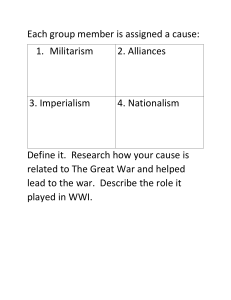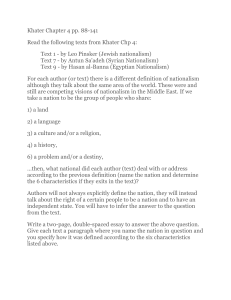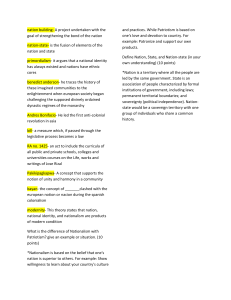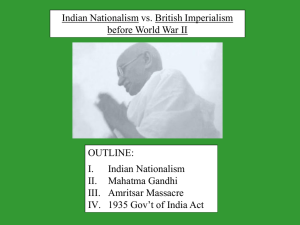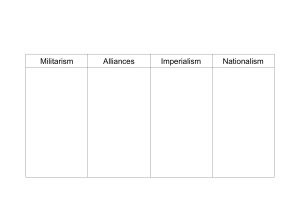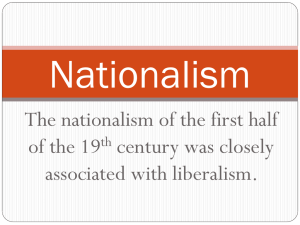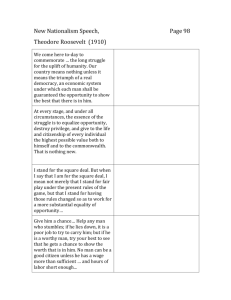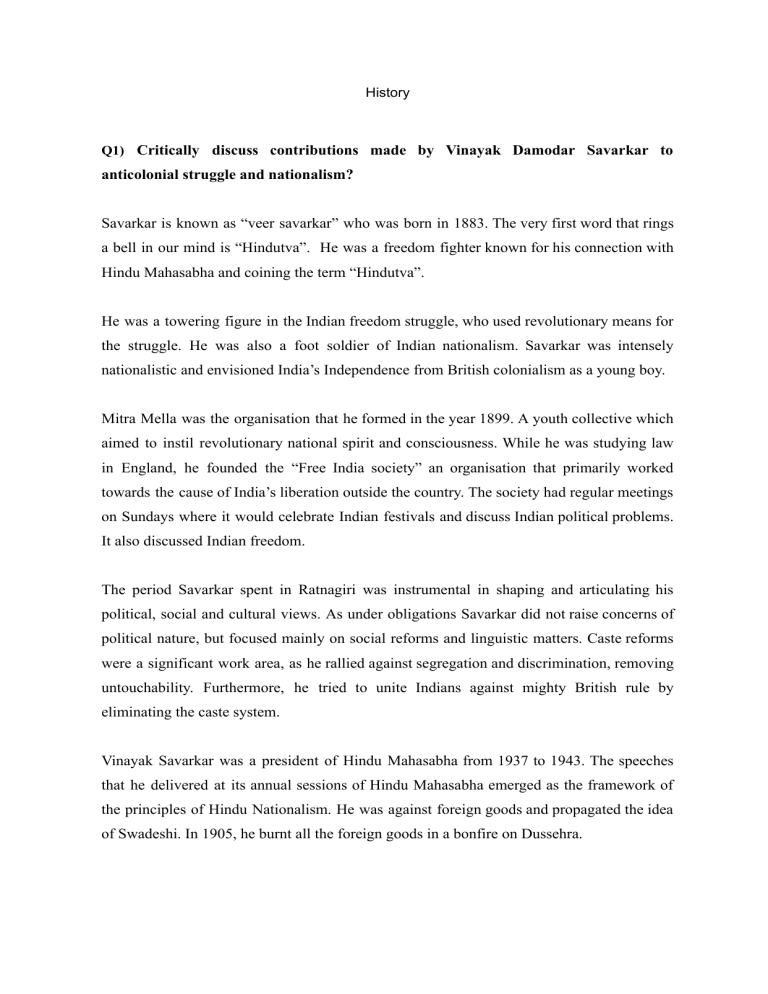
History Q1) Critically discuss contributions made by Vinayak Damodar Savarkar to anticolonial struggle and nationalism? Savarkar is known as “veer savarkar” who was born in 1883. The very first word that rings a bell in our mind is “Hindutva”. He was a freedom fighter known for his connection with Hindu Mahasabha and coining the term “Hindutva”. He was a towering figure in the Indian freedom struggle, who used revolutionary means for the struggle. He was also a foot soldier of Indian nationalism. Savarkar was intensely nationalistic and envisioned India’s Independence from British colonialism as a young boy. Mitra Mella was the organisation that he formed in the year 1899. A youth collective which aimed to instil revolutionary national spirit and consciousness. While he was studying law in England, he founded the “Free India society” an organisation that primarily worked towards the cause of India’s liberation outside the country. The society had regular meetings on Sundays where it would celebrate Indian festivals and discuss Indian political problems. It also discussed Indian freedom. The period Savarkar spent in Ratnagiri was instrumental in shaping and articulating his political, social and cultural views. As under obligations Savarkar did not raise concerns of political nature, but focused mainly on social reforms and linguistic matters. Caste reforms were a significant work area, as he rallied against segregation and discrimination, removing untouchability. Furthermore, he tried to unite Indians against mighty British rule by eliminating the caste system. Vinayak Savarkar was a president of Hindu Mahasabha from 1937 to 1943. The speeches that he delivered at its annual sessions of Hindu Mahasabha emerged as the framework of the principles of Hindu Nationalism. He was against foreign goods and propagated the idea of Swadeshi. In 1905, he burnt all the foreign goods in a bonfire on Dussehra. He was charged with sedition by the British government for his revolutionary activity and he was sentenced. It is essentials and noteworthy the andaman jail inmates were hardened revolutionaries and they were sent there as a form of toughest incarceration Although, Hindu Mahashabha did not play a large role at the end of the Indian freedom struggle from the British, However his role cannot be downplayed in the buildup of the momentum of the Indian freedom struggle in the beginning of the 20th Century when it was at a very nascent stage. Q2) Critically examine the degeneration of civic nationalism into ethnic nationalism in india? Ethnic Nationalism is a theory which states that the nation is created by a shared ethnic and/or cultural Identity. Basically people with common language, religion customs and cultural traditions are united through their commonalities and form a nation. This nation is the basis for the state, the political structures and borders. Civic Nationalism defines the sense of belonging through citizenship and political equality. Civic nationalisation is directly linked to liberalism, meaning the ideology that elevates liberty and equality above all else leading to political belief in the freedom of speech, religion and press etc. With Civic nationalism every individual has equal access to nationhood without being blocked. In India the growth of Nationalism is connected to the anti-colonial movement. People began discovering their unity in the process of their struggle with colonialism. The sense of being oppressed under colonialism provided a shared bong that tied many different groups together. However, each class of groups felt the effects of colonialism differently. Political ideologies of both Gandhi and Nehru became incorporated in the politics of Indian National Congress (INC). INC became a supporter of secular school of thought in India to separate state and religion. In the effort to provide equality of rights and duties to the multiethnic, multi-religious and multi-cultural society in India. However, within the realm of secularism, Hindu Nationalism crept back into Indian society. In contemporary India, the ethnic, cultural and religious form of nationalism are incorporated into the political ideology The concept of “Hindu-ness” as defined by D. Savarkar became a term synonyms with Hindu Nationalism in India before her Independence. This embodied the cultural nationality of Bharat (India) that is Hindu, and whosoever lives in the state. Since BJP is torch bearer of the Hindutva Ideology it raises genuine concerns for the minorities such as Muslims. RSS is the foremost organisation that follows the Hindu Ideology. The RSS has been involved in re-telling, the story of India by focusing on the contributions of Hindus and excluding all others. According to Anuja Bose “as part of its efforts to regulate what and how Indian learn, the RSS often seeks a ban on books that present disagreeable views on Hindusism” RSS and its sister organisations are intent upon silencing anyone representing an opposing view. As a multi ethnic and multi-cultural society India has managed to rise up to the standards of a multicultural state, with several ethnically, linguistically and culturally diverse groups residing in India. The basis of Indian nationalism was established by pioneers like Gandhi and Nehru who accepted the diversity of India as its strength. This diversity was utilized in the Cold war era in which India‟s new nationalism and post-colonial statism under the umbrella of modernism flourished. Subsequently, though this statist nationalism, could not sustain, as ethnic nationalism revived its already established political base. In the post-cold war the liberal nationalist school of thought steadily began its decline and ethnic nationalism made its way in to the mainstream. The rise of Hindutva is India is credited to the BJP; the awakening of the „Hindu‟ mindset has brought to light centuries old conflicts that have forever plagued the Indian society. The diversity of India that was once claimed its strength by leaders like Nehru has become a major threat in the contemporary scenario. q3) critically examine why religious identity in India became so rapidly politicised in the 1980s. - Operation blue ke waja se punjab main kya hua - Ramjanma bhum movment ke waje se india main kya
